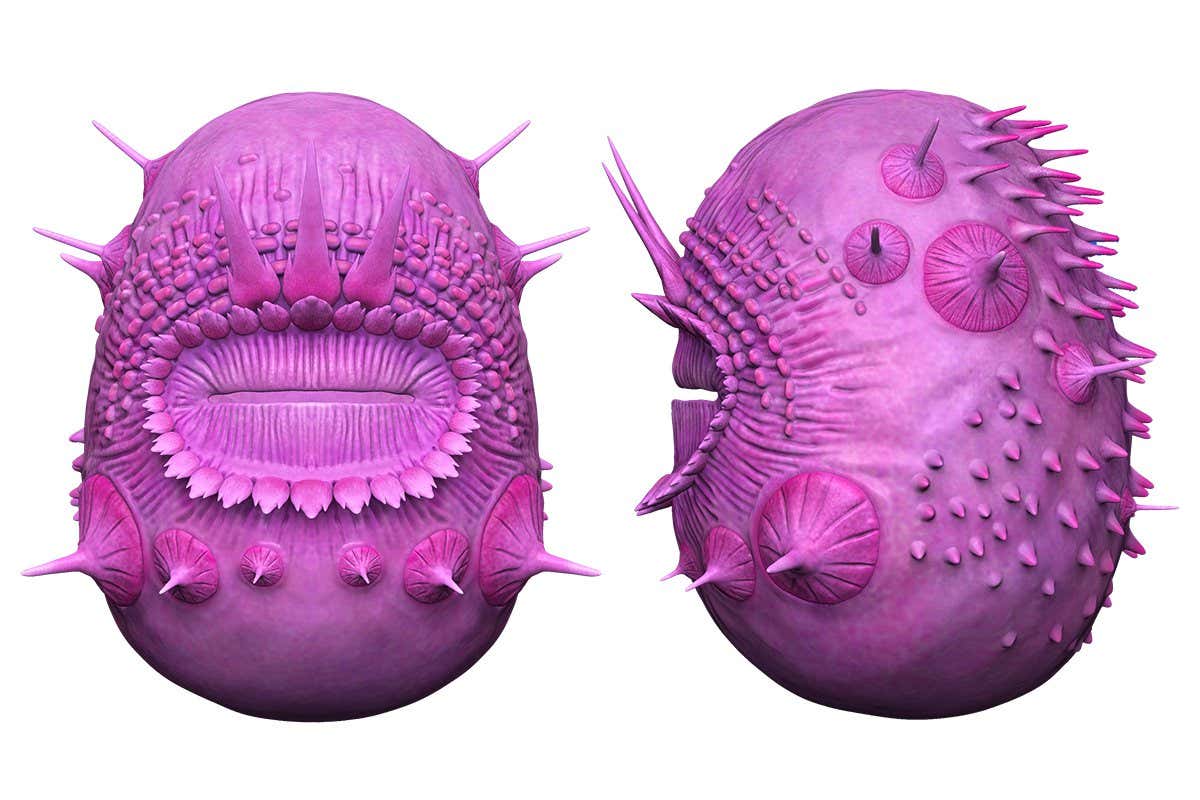Saccorhytus coronarius lived around 500 million years ago and was thought to be a common ancestor of deuterostomes, making it the earliest known ancestor of humans, but it turns out to be on another branch of life
Life 17 August 2022
By Carissa Wong
A reconstruction of Saccorhytus coronarius
Yunhuan Liu, School of Earth Science and Resources, Chang?an University, Xi'an, China – and colleague
Our earliest ancestor may not be a tiny anusless sac with a huge mouth after all. The claim was first made in 2017 but new evidence suggests the creature, which lived around 530 million years ago during the early Cambrian period, was probably an early ancestor of animals such as crabs and spiders.
Fossils of the sac-like animal (Saccorhytus coronarius) collected from the Kuanchuanpu Formation in South China suggest it was around 1.3 millimetres long and had a huge mouth – roughly half a millimetre wide – through which it probably both fed and excreted. It is thought to have lived on the sea floor.
“It would have either absorbed all of the matter it fed on or else the mouth served as an anus as well,” says Philip Donoghue at the University of Bristol in the UK.
Advertisement
Simon Conway Morris at the University of Cambridge and his colleagues previously analysed 45 poorly preserved S. coronarius specimens and suggested that a set of small openings surrounding its mouth were the evolutionary precursors to gills that are now seen in fish. That in turn led them to propose that the creature was a common ancestor of deuterostomes, a broad group in the animal kingdom to which humans belong, making it our earliest known ancestor and that of all other vertebrates.
Donoghue and his colleagues now have evidence to say this isn’t the case. The team collected several hundred more S. coronarius specimens, many of which are well-preserved, by using a weak acid to dissolve hundreds of kilograms of rock from the same site in South China, revealing the fossils.
By imaging the specimens using a high-resolution technique called synchrotron tomography, the team found three-pointed spikes not seen in the previous fossils, suggesting that the supposed gill-precursors around S. coronarius’ mouth were probably holes left over from spikes that had broken off at their bases.
“We can see in our fossils that there was another layer of tissue preserved that extended up through these holes and created spines,” says Donoghue. “Since the interpretation of those holes was the key evidence for interpreting the animal as a deuterostome, the lack of these openings basically pulls the rug from under that interpretation completely.”
Instead, S. coronarius probably belonged to a major group of animals called the ecdysozoans, which includes insects, crustaceans and roundworms. The spikes probably helped it to catch prey – although it is unclear what it would have eaten.
“Living animals like penis worms have the same arrangement of spines and they use them as part of capturing prey – basically, the mouth rotates inwards and the spines drag the food material into the mouth,” says Donoghue. “It must have been some sort of predator, because of these spines, but we know absolutely nothing about what it ate.”
The findings suggest that S. coronarius cannot fill a gap in the fossil record that exists before the sudden appearance of a large diversity of animals. “It was argued that the common ancestors of deuterostomes were just so small that they are invisible in the fossil record. So S. coronarius being a deuterostome [which is now unlikely] would have supported that idea,” says Donoghue.
Conway Morris declined to comment on the new work when contacted by New Scientist.
“The study is comprehensive, rigorous and compelling, removing the key feature supporting placement of this fossil with deuterostomes. As such, there is no longer a strong case for interpreting S. coronarius as an early deuterostome,” says Imran Rahman at the Natural History Museum in London.
But that doesn’t mean the hunt for other early deuterostomes – and perhaps our earliest ancestor – is over, he says. “An assortment of other enigmatic fossils are known from the Cambrian period, some of which may yet find a home in the deuterostome tree,” says Rahman. “I remain optimistic that in the coming years we will be able to piece together the earliest steps in deuterostome evolution based on fossil specimens.”
Journal reference: Nature, DOI: 10.1038/s41586-022-05107-z
Sign up to Wild Wild Life, a free monthly newsletter celebrating the diversity and science of animals, plants and Earth’s other weird and wonderful inhabitants
More on these topics:
































